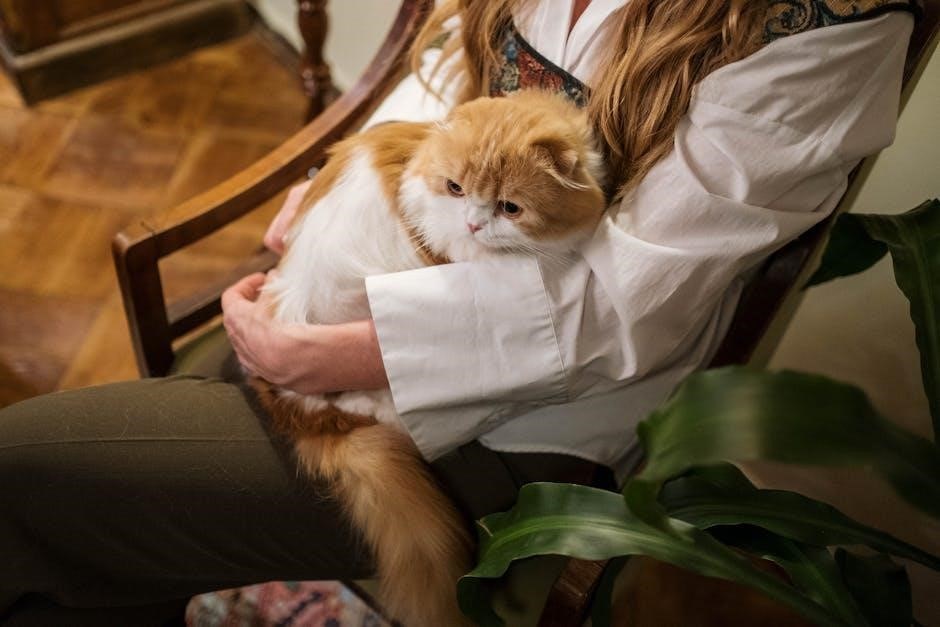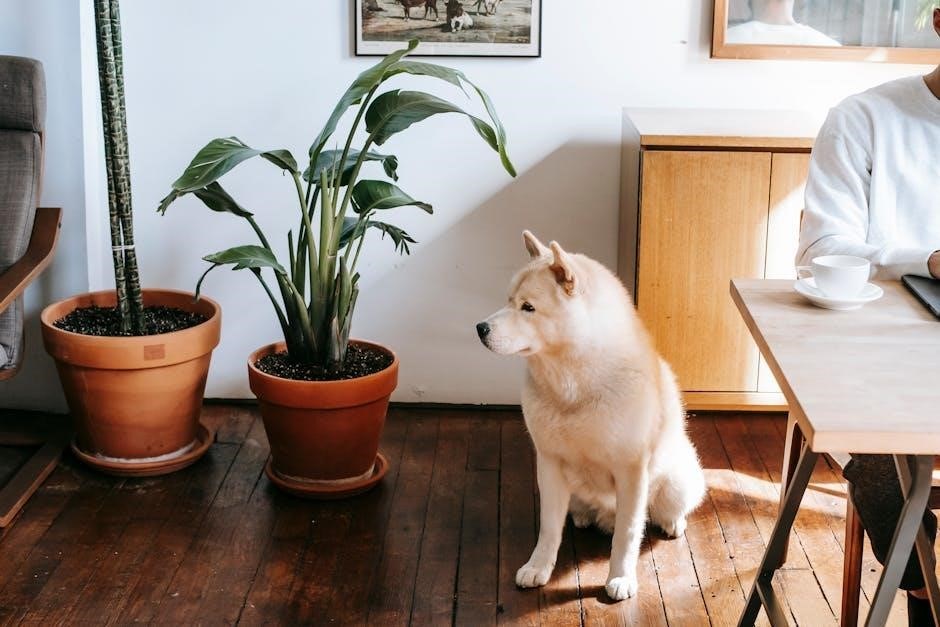Protecting pets from toxic plants is crucial for their health and safety. Many common household and garden plants can be harmful, causing serious illness or even death. Awareness of which plants are safe and which are dangerous is essential for pet owners; This guide provides valuable insights and practical tips to help you create a pet-friendly environment while enjoying the beauty of plants.
Common Toxic Plants to Pets
Certain plants pose serious health risks to pets, with lilies, sago palms, and snake plants being particularly dangerous. These can cause vomiting, diarrhea, lethargy, and even organ failure in pets.
Lilies
Lilies are highly toxic to pets, especially cats, and can cause severe health issues. Even small amounts of pollen or leaves can lead to vomiting, lethargy, and kidney failure. The entire lily plant, including the water in vases, poses a significant risk to pets. If ingested, immediate veterinary attention is crucial to prevent life-threatening complications. Keeping lilies out of reach is essential for pet safety. Opting for non-toxic alternatives can help maintain a beautiful and hazard-free environment for your furry friends.

Sago Palms
Sago palms are highly toxic to pets, containing a toxin called cycasin that can cause severe liver damage. Even small amounts of the plant, especially the seeds, can be fatal if ingested. Symptoms include vomiting, diarrhea, lethargy, and liver failure, which can progress rapidly. Pets are often drawn to the plant’s attractive appearance, increasing the risk of accidental poisoning. Immediate veterinary care is essential if ingestion occurs. Removing sago palms from pet-accessible areas and choosing non-toxic alternatives is the safest option for pet owners to prevent this potentially life-threatening hazard.
Snake Plants
Snake plants, also known as Mother-in-Law’s Tongue, are popular for their low-maintenance and air-purifying qualities. However, they are toxic to pets due to the presence of calcium oxalate crystals, which can cause oral and gastrointestinal irritation. If ingested, pets may experience symptoms like drooling, vomiting, or lethargy. While not typically fatal, consuming snake plants can still lead to significant discomfort for your pet. It’s important to keep these plants out of reach or consider alternative, non-toxic options to ensure your pet’s safety and well-being.
Oleander
Oleander is a highly toxic plant for pets, containing cardiac glycosides that can cause severe health issues. Even small amounts ingested can lead to cardiac arrhythmias, tremors, and gastrointestinal distress. Pets may exhibit symptoms like vomiting, diarrhea, or lethargy shortly after exposure. In severe cases, oleander toxicity can result in heart failure or death. It is crucial to avoid having oleander in pet-accessible areas and dispose of any plant debris carefully. If you suspect your pet has ingested oleander, contact a veterinarian or pet poison hotline immediately for emergency assistance.
Castor Bean
The castor bean plant is highly toxic to pets, particularly its seeds, which contain the toxic compound ricin. Ingestion can cause severe gastrointestinal issues, including vomiting, diarrhea, and abdominal pain. Ricin also affects the central nervous system, leading to symptoms like tremors, seizures, and lethargy. In severe cases, it can result in organ failure and death. Even small amounts of the plant can be dangerous, so it is essential to keep castor beans out of reach of pets. If ingestion occurs, seek immediate veterinary care, as prompt treatment is critical for survival. Always dispose of plant debris carefully to prevent accidental exposure.
Safe Plant Alternatives for Pet-Friendly Spaces
Choose pet-safe plants like spider plants, ZZ plants, and cat grass to create a beautiful, non-toxic environment for your furry friends to thrive in safely indoors.
Spider Plants
Spider plants are an excellent choice for pet-friendly spaces, as they are non-toxic to both dogs and cats. Their air-purifying qualities and elegant, cascading leaves make them a popular option for indoor gardens. Easy to care for, spider plants thrive in various lighting conditions and require minimal maintenance. They are also great for propagation, as their baby plants, or spiderettes, can be easily shared or replanted. Unlike many other plants, spider plants pose no risk to your pets, making them a safe and stylish addition to any room. Their versatility and safety ensure they remain a favorite among pet owners who love greenery.
ZZ Plants
ZZ plants are a fantastic option for pet-friendly spaces due to their low-maintenance nature and non-toxic properties. These plants are known for their glossy, dark green leaves and ability to thrive in low-light conditions, making them perfect for indoor spaces. Unlike many other plants, ZZ plants are safe for both dogs and cats, ensuring peace of mind for pet owners. Their air-purifying qualities also contribute to a healthier home environment. With minimal watering and care required, ZZ plants are an ideal choice for busy households. They add a touch of greenery without posing any risk to your furry friends, making them a practical and stylish addition to any pet-friendly home.
Cat Grass
Cat grass is a highly recommended, non-toxic plant for pet-friendly environments, particularly for feline companions. It is specifically cultivated for cats to graze on, satisfying their natural instinct to chew on grass. Unlike toxic plants, cat grass is safe and even beneficial, aiding in digestion and reducing hairballs. It is easy to grow indoors, requiring minimal care and sunlight. Cat grass is a great alternative to dangerous houseplants, providing a healthy outlet for your cat’s curiosity. By incorporating cat grass into your home, you can create a safe and stimulating space for your pets to enjoy, ensuring their well-being while adding a touch of greenery to your decor.
Parlor Palm
The Parlor Palm is a stylish and pet-safe option for indoor spaces, offering a tropical aesthetic without the risk of toxicity. Native to Central America, this palm is known for its slender leaves and elegant growth habit. It thrives in low-to-medium light conditions, making it ideal for homes with varying sunlight exposure. Additionally, it is relatively low-maintenance, requiring only occasional watering and fertilization. The Parlor Palm is a popular choice among pet owners due to its safety for both dogs and cats. By adding this plant to your home, you can enjoy the beauty of nature while ensuring the well-being of your furry companions. Its versatility and charm make it a perfect fit for pet-friendly interiors.

Identifying Symptoms of Plant Toxicity in Pets
Recognizing symptoms of plant toxicity in pets is crucial for timely intervention. Common signs include vomiting, diarrhea, lethargy, and tremors, with severe cases leading to seizures or organ failure. Prompt veterinary care is essential to prevent life-threatening complications.
Gastrointestinal Issues
Gastrointestinal issues are among the most common symptoms of plant toxicity in pets. These may include vomiting, diarrhea, and excessive drooling, often occurring shortly after ingestion. In some cases, pets may exhibit abdominal pain or lack of appetite. Certain plants, like lilies, can cause immediate gastrointestinal distress, while others, such as sago palms, may lead to more severe digestive complications. It’s crucial to monitor your pet’s behavior and health closely, as persistent or worsening symptoms can indicate the need for urgent veterinary care. Early recognition of these signs can help prevent more serious health complications and ensure timely treatment.
Neurological Symptoms
Neurological symptoms can arise if a pet ingests highly toxic plants, often leading to severe health complications. Signs may include tremors, seizures, lethargy, or unsteady movement. Plants like lilies and sago palms contain toxins that can affect the nervous system, causing these symptoms. In some cases, pets may exhibit abnormal behavior, such as agitation or disorientation. If you suspect your pet has ingested a toxic plant, it’s critical to seek veterinary care immediately, as neurological damage can progress rapidly. Early intervention is key to preventing long-term harm or even life-threatening conditions. Recognizing these signs quickly can make a significant difference in your pet’s recovery.
Respiratory Distress
Respiratory distress is a concerning symptom that can occur in pets after ingesting toxic plants. Signs include rapid breathing, panting, or difficulty breathing, which may indicate inflammation or irritation in the airways. In severe cases, pets may exhibit blue-tinged gums (cyanosis) due to low oxygen levels. Plants like sago palms and lilies contain toxins that can trigger these respiratory issues, even in small amounts. If your pet shows these symptoms, seek immediate veterinary care to prevent complications. Prompt treatment is essential to ensure your pet’s airways remain clear and functioning properly, avoiding long-term damage or life-threatening conditions; Always monitor your pet’s behavior around plants to act quickly if needed.

Practical Tips for Pet-Friendly Gardening
Ensure pet safety by choosing non-toxic plants, keeping harmful varieties out of reach, and using deterrents like sprays to prevent accidental ingestion or contact with toxic species.

Keeping Plants Out of Reach
To prevent accidental ingestion, place toxic plants on high shelves or hanging baskets where pets cannot access them. Use secure fences or barriers for garden areas with hazardous plants. Regularly inspect your space to ensure no dangerous plants are within your pet’s reach. Supervise interactions between pets and plants, especially in new environments. This proactive approach helps minimize the risk of poisoning and ensures a safer living space for your furry friends.
Using Pet-Deterrent Sprays
Applying pet-deterrent sprays is an effective way to discourage pets from approaching plants. These sprays often contain natural ingredients like citrus or vinegar, which are unpleasant to animals. Spray them directly on the leaves or stems of plants to create an unappealing taste or smell. Homemade solutions, such as mixing lemon juice with water, can also work. Commercial sprays are widely available and specifically designed for this purpose. While these sprays are not harmful to pets, they help train them to avoid certain areas. Consistent use can reinforce boundaries, though supervision is still recommended to ensure pets do not find ways to bypass the deterrents.

Supervising Pet-Plant Interactions
Supervising interactions between pets and plants is vital to prevent accidental ingestion of toxic species. Even with precautions, pets may still explore their surroundings, making constant vigilance necessary. Keep an eye on your pets when they are near plants, especially those known to be toxic, such as lilies or sago palms. Early detection of plant chewing or ingestion allows for prompt intervention, which can prevent severe health issues. If you notice unusual behavior or symptoms like vomiting, lethargy, or tremors, seek veterinary help immediately. Supervision ensures pet safety and helps maintain a harmonious, plant-filled home environment. Stay alert to protect your furry friends from potential dangers.

Important Resources for Pet Owners
Consult the ASPCA’s list of toxic plants and contact veterinary hotlines for emergencies. These resources provide essential guidance and immediate support to ensure pet safety and well-being.
ASPCA Guidelines for Toxic Plants
The ASPCA provides comprehensive guidelines on toxic plants, categorizing them based on their toxicity levels. Their database lists plants as non-toxic, mildly toxic, or highly toxic, helping pet owners identify risks. For example, lilies are highly toxic to cats, causing severe kidney damage, while sago palms are deadly to both dogs and cats due to their toxic seeds. The ASPCA also offers a searchable list of toxic and non-toxic plants, making it easy for owners to reference. This resource is invaluable for preventing accidental poisoning and ensuring a safe environment for pets. Always consult the ASPCA’s Animal Poison Control Center hotline for emergencies.

Veterinary Hotlines for Emergencies
Veterinary hotlines are a lifeline in plant poisoning emergencies; The ASPCA Animal Poison Control Center (APCC) at (888) 426-4435 and the Pet Poison Helpline at (855) 213-6680 provide 24/7 expert advice. These services offer guidance on symptoms, treatment, and urgent care. If your pet ingests a toxic plant, contact these hotlines immediately. Be prepared to provide details about the plant and your pet’s symptoms for accurate assistance. Quick action can prevent severe poisoning and save lives. Always keep these numbers handy to ensure rapid response in critical situations, safeguarding your pet’s health and well-being.
